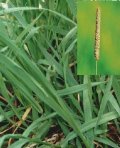
Timothy

Timothy
(High-resolution
image available)
NOTE: The information in this Agnote must be read in conjunction with Introduction to selecting and using pastures in NSW, which covers information on areas of adaptation, sources of variability, species mixtures, and important issues related to animal health and the conservation of native vegetation.
| Pasture type and use | Perennial grass. Main growth in spring, summer and autumn. Grown under irrigation or high-rainfall conditions, primarily for grazing of sheep and cattle. Can also be used for hay or silage. |
|---|---|
| Area of adaptation | Has not been fully assessed. Expected to be successful only in the higher-rainfall areas of the Northern and Central Tablelands and in irrigation areas, with limited use in the Hunter, Northern and Central Coast areas. In trials conducted on acid soils on the Northern Tablelands between 1958 and 1961, Timothy produced less than did tall fescue, cocksfoot and perennial ryegrass, but more than phalaris and Italian ryegrass. |
| Min. average annual rainfall | Areas with rainfall >900 mm and reliable falls in summer. |
| Advantages |
|
| Disadvantages |
|
| Soil requirements | Best suited to heavy, damp, fertile soils. |
| Varieties |
|
| Sowing rates: | |
| - as only species | 5-8 kg/ha |
| - in mixtures | 1-2 kg/ha |
| Sowing time | Early autumn (February to April) or spring (mid-August/September) in favourable-rainfall areas. |
| Companion species |
|
| Inoculation | N/A |
| Major nutrient deficiencies | Nitrogen, phosphorus and sulfur. |
| Main insect pests | Unknown at this stage, but assume insects affecting other temperate grasses will also affect this species. Monitor for insects such as pasture scarabs, blue oat mites, redlegged earth mites, field crickets, slugs and snails. |
| Main diseases | Unknown, but may suffer from stem and stripe rusts and other minor leaf diseases. |
| Management | As a generalisation, requires lax rotational grazing, and at key maturity stages (stem elongation to heading and during tiller initiation), infrequent grazing.
Lax rotational grazing (to residual height of 30-50 mm) generally gives best yields. Grazing management must be such as to allow the plant to ‘head’ in late spring/early summer (lax and infrequent grazing) in order to build up root reserves and also to allow the formation of new tillers in the late summer/autumn period. |
| Livestock disorders of particular note | No livestock disorders encountered. |
| Additional tips | If intending to produce hay, the addition of a nitrogenous fertiliser may be considered in order to increase yield, where it is economic to do so. |
Acknowledgments
Advice on livestock health disorders was provided by Dr Chris Bourke, Principal Research Scientist, NSW Agriculture, Orange. His contribution is gratefully acknowledged.
Photo: Pyne Gould Guinness Seeds

